sensor MERCEDES-BENZ SL-Class 2013 R131 Owner's Manual
[x] Cancel search | Manufacturer: MERCEDES-BENZ, Model Year: 2013, Model line: SL-Class, Model: MERCEDES-BENZ SL-Class 2013 R131Pages: 590, PDF Size: 9.73 MB
Page 9 of 590

Display
........................................... 522
Exhaus tpipe .................................. 522
Exterior lights ................................ 521
Gea rors elector lever .................... 522
Interior ........................................... 522
Matte finish ................................... 520
Notes ............................................. 517
Paint .............................................. 519
Plastic trim .................................... 522
Power washer ................................ 519
Rea rview camera .......................... 521
Roof lining ...................................... 524
Seat bel t........................................ 524
Seat cover ..................................... 523
Sensors ......................................... 521
Steering wheel ............................... 522
Trim pieces .................................... 523
Washing by hand ........................... 518
Wheels ........................................... 520
Windows ........................................ 520
Wiper blades .................................. 521
Wooden trim .................................. 523
Car keys
see SmartKey
Car pool lanes .................................... 317
Car wash (care) ................................. 517
Category lis t(music search) ............448
CD Cop yprotection ............................. 447
Fast forward/fast rewind ...............443
General information .......................447
Inserting ........................................ 436
Mode ,switchin gto........................ 439
Multisession .................................. 446
Notes on discs ............................... 447
Pause function ............................... 441
Player/change roperation
(COMAND )..................................... 436
Safety notes .................................. 436
Selecting amedia type .................. 441
Selecting atrack ............................ 442
Sound settings (balance, bass,
treble )............................................ 295
CD/DVD
Ejecting (DVD drive )....................... 438
Inserting (DVD changer )................ 436
Inserting (single DVD drive )........... 436
Removing (single DVD drive) .......... 436 CD mode
Playback options ........................... 446
CD player/CD changer (on-board
computer) .......................................... 228
Center console Lowe rsection .................................. 47
Lowe rsection (AMG vehicles) ..........48
Uppe rsection .................................. 46
Central locking
Automatic locking (on-board
computer) ...................................... 235
Locking/unlocking (SmartKey) ........84
Changing direction
Announcement phase ....................342
Change of direction phase .............342
Preparation phase .........................342
Changing the character set ..............302
Channel presets ................................ 428
Characters Changing the character set ............ 300
Changing the language ..................300
Deleting ......................................... 300
Entering ......................................... 301
Entering (address book, phone
book) ............................................. 299
Entering (navigation) ......................301
Moving the curso r.......................... 300
Switching to letters ........................ 300
Children
In the vehicle ................................... 70
Restraint systems ............................ 70
Specia lseat belt retractor ...............72
Child seat
LATCH-type (ISOFIX) child seat
anchors ............................................ 72
Cigarette lighter ................................ 496
Cleaning Mirro rturn signal ........................... 521
Clear button ....................................... 292
Climate control Automatic climate control (dual-
zone) .............................................. 141
Controlling automatically ...............144
Cooling with aird ehumidification..143
Defrosting the windows .................147
Defrosting the windshield ..............146
Important safety notes ..................140
Indicator lamp ................................ 144 Index
7
Page 16 of 590

iTunes
®
.............................................. .465 J
Jack Storage location ............................ 526
Using ............................................. 567
Jump starting (engine) ......................534 K
KEYLESS-GO Convenience closing feature .......... 101
Display message ............................ 268
Locking ............................................ 85
Start/Stop button .......................... 155
Starting the engine ........................157
Unlocking ......................................... 85
Keyp ositions
KEYLESS-GO .................................. 155
SmartKey ....................................... 155
Kickdown
Driving tips .................................... 167
Manual drive program ....................171
Knee bag .............................................. 57L
Lamps see Warning and indicator lamps
Lane Keeping Assist
see Active Lane Keeping Assist
Lane recommendations
Explanation .................................... 343
Presentation .................................. 343
Lap time (RACETIMER) ......................237
LATCH-type (ISOFIX) child seat
anchors ................................................ 72
License plate lamp (display
message) ............................................ 252
Light function ,active
Display message ............................ 253
Lighting
Ligh tswitc h................................... 126
Lights
Activating/deactivating the
interio rlighting delayed switch-off .234
Active light function .......................131
Automatic headlamp mode ............126 Cornering light function
.................130
Driving abroad ............................... 126
Hazard warning lamps ...................130
High beam flasher .......................... 130
High-beam headlamps ...................129
Low-beam headlamps ....................127
Parking lamps ................................ 128
Setting the brightness of the
ambient lighting (on-board
computer) ...................................... 233
Setting the color of the ambient
lighting (on-board computer) .........233
Standing lamps .............................. 128
Switching Adaptive Highbeam
Assist on/off ................................. 233
Switching the daytime running
lamps on/off (on-board computer) 233
Switching the exterio rlighting
delayed switch-off on/off (on-
board computer )............................ 234
Switching the surround lighting
on/off (on-board computer) ..........234
Turn signals ................................... 129
see Interior lighting
Light sensor (display message) .......253
Load/eject button .............................436
Loading aid (trunk) Raising/lowering the roof ..............492
Locking
see Centra llocking
Locking (doors)
Automatic ........................................ 92
Emergency locking ........................... 93
From inside (central locking
button) ............................................. 91
Locking centrally
see Centra llocking
Locking verification signal (on-
board computer) ............................... 235
Low-beam headlamps Display message ............................ 251
Setting for driving abroad
(symmetrical) ................................. 126
Switching on/off ........................... 127
Luggage cover
see Trunk partition
Lumbar support
Adjusting (COMAND) .....................31114
Index
Page 20 of 590

Parking brake
Display message ............................ 243
Electric parking brake ....................176
Warning lamp ................................. 276
Parking lamps
Switching on/off ........................... 128
PARKTRONIC
Deactivating/activating .................205
Driving system ............................... 203
Function/notes ............................. 203
Important safety notes ..................203
Problem (malfunction) ...................206
Range of the sensors .....................203
Warning displa y............................. 204
PASSENGE RAIR BAG OFF indicator
lamp ...................................................... 59
Pause function Audio mode (CD, DVD, MP3) .........441
Video DVD ..................................... 471
Personal POIs
Acoustic notification ......................337
Calling up the menu .......................336
Displaying on the map ...................336
Managing categories .....................337
Saving ............................................ 338
Selecting as the destination ..........339
Settings ......................................... 336
Visual information ..........................337
Phone book
Adding a numbe rto an address
book entry. .................................... 391
Calling up ....................................... 388
Creating anew entry ..................... 390
Deleting an entry ........................... 390
Entering characters .......................299
Icon overview ................................. 389
Searching for an entry ...................389
Picture settings (TV, video) ..............468
Picture viewer Displaying pictures ........................475
Introduction ................................... 475
Plastic trim (cleaning instructions) .522
Playback options Audio mode (CD, DVD, MP3) .........446
POI (navigation)
Category ........................................ 333
Defining the position for the POI
search ............................................ 332 Entering
......................................... 330
Entering a point of interest using
the map ......................................... 335
List ................................................. 333
ZAGAT ®
surve yservice .................. 335
see Personal POIs
Point of interest icon
Setting ........................................... 364
Point of interest list
With character bar .........................334
Power closing feature .........................92
Power washers .................................. 519
Power windows see Side windows
PRE-SAFE ®
(anticipatory occupant
protection) Display message ............................ 246
Operation ........................................ .64
PRE-SAFE ®
Brake
Activating/deactivating .................231
Display message ............................ 247
Function/notes ................................ 79
Warning lamp ................................. 279
Previous destinations (navigation) ..361
Product information ............................34
Program selector button ..................167
Protection of the environment General notes .................................. 34
Pulling away (automatic
transmission) ..................................... 158 Q
Qualifie dspecialis tworkshop ...........38 R
RACE START Important safety notes ..................196
RACETIMER (on-board computer) ....237
Radar sensor system Activating/deactivating .................235
Display message ............................ 258
Radio
Overview ........................................ 426
Selecting astation ......................... 228
Setting astation ............................ 42818
Index
Page 22 of 590

S
Safety Children in the vehicle .....................70
Child restraint systems ....................70
Occupant Classification System
(OCS) ............................................... 59
Safety notes
Audio CD/DVD and MP3 mode .....436
Using the telephone ....................... 376
Video DVD mode ........................... 468
Safety system
see Driving safety systems
SatRadio
Displaying information ...................435
Notes ............................................. 431
Registering .................................... 431
Selecting acategor y...................... 433
Switching to ................................... 432
Saving the crosshair position ..........363
SD memory card Ejecting .......................................... 439
Inserting ........................................ 439
Searc h&Send................................... 340
Seat belts Adjusting the driver's and front-
passenger sea tbelt ......................... 68
Belt force limiters ............................ 69
Cleaning ......................................... 524
Correct usage .................................. 66
Emergency Tensioning Devices ....... .69
Fastening ......................................... 67
Important safety guidelines .............65
Releasing ......................................... 68
Safety guidelines ............................. 53
Seat belt guide ............................... 117
Switching belt adjustment on/off
(on-board computer) ......................236
Warning lamp ................................. 270
Warning lamp (function) ................... 68
Seats
Active multicontour sea t................ 311
Adjusting (electrically). ..................116
Adjusting the head restraint ..........117
Adjusting the lumba rsupport
(COMAND )..................................... 311
Balance (sea theating) ................... 312
Belt guide ...................................... 117Cleaning the cover
.........................523
Correct driver's sea tposition ........114
Important safety notes ..................115
Massag efunction .......................... 313
Multicontour sea t.......................... 311
Overview ........................................ 115
Resetting settings ..........................314
Seat functions (COMAND) .............310
Seat heating problem ....................119
Seat ventilation problem ................119
Selecting for adjustment
(COMAND) ..................................... 311
Sliding forward/back .....................118
Storing settings (memory function) 124
Switching AIRSCARF on/off ..........120
Switching sea theating on/off .......118
Switching seat ventilation on/off ..119
Selecting aprovince ......................... 319
Selecting astate ............................... 319
Selecting stations Radio ............................................. 428
Selector lever
Cleaning ......................................... 522
Positions ........................................ 163
Sending DTMF tones .........................386
Sensors (cleaning instructions) .......521
Service menu (on-board computer) .231
Service products Brake fluid ..................................... 582
Coolant (engine) ............................ 582
Engine oil ....................................... 581
Fuel ................................................ 579
Important safety notes ..................578
Refrigerant (air-conditioning
system) .......................................... 584
Washer fluid .................................. .583
Service work
see ASSYST PLUS
Settings
Factory (on-board computer) .........232
Menu overview .............................. 287
On-board computer .......................232
Picture (COMAND) .........................468
Sound settings ............................... 295
Setting the air distribution ...............145
Setting the airflow ............................146
Setting the language COMAND ....................................... 30620
Index
Page 55 of 590

restraint systems for infants and children
(Y page 70). SRS (Supplemental Restraint System)
Introduction SRS consists of:
R
the 001B SRS warning lamp
R air bags
R the air bag control unit with crash sensors
R Emergency Tensioning Devices
R beltf orce limiters
SRS reduces the risk of occupants coming
into contact with the vehicle's interior in the
event of an accident. It can also reduce the
effect of the forces to which occupants are
subjected during an accident.
SRS warning lamp G
WARNING
The SRS self-chec khas detected a
malfunction if the 001BSRS indicator lamp:
R does no tlight up at all
R does not go out after approximately four
seconds after the engine is started
R lights up after the engin eis started or while
the vehicle is in motion
For your safety, Mercedes-Benz strongly
recommends that you have the system
checked as soon as possible at a qualified
specialist workshop. SRS may otherwise fail
to activate when it is needed in the event of
an accident, which could lead to serious or
fatal injuries. SRS might also be activated
unexpectedly and unnecessarily, which could
also result in injury.
In addition, work carried out improperly on
SRS may render SRS inoperative or cause
unintended air bag deployment. Work on the
SRS system should only be carried out by
qualified specialist personnel. Consult a
qualified specialist workshop. If it is necessary to modify an air bag system
to accommodate a person with disabilities,
contact an authorized Mercedes-Benz Center
for details. USA only: for further information,
contact our Customer Assistance Center at
1-800-FOR-MERCedes (1-800-367-6372).
The 001B SRS warning lamp in the instrument
cluster lights up when the ignition is switched
on. It goes out no later than a few seconds
after the engine is started.
SRS functions are checked regularly when the
engine is running. Therefore, malfunctions
can be detected in good time.
The SRS components are in operational
readiness when the SRS 001Bindicator lamp
goes out while the engine is running.
Safety guidelines for seat belts,
Emergency Tensioning Devices (ETDs)
and air bags G
WARNING
R Damaged seat belts or seat belts that have
been subjected to stress in an accident
must be replaced. Their anchoring points
must also be checked. Only use seat belts
installed or supplied by an authorized
Mercedes-Benz Center.
R Air bags and pyrotechnic Emergency
Tensioning Devices (ETDs) contain
perchlorate material, which may require
special handling and regard for the
environment.C heck your national disposal
guidelines. California residents, see
www.dtsc.ca.gov/HazardousWaste/
Perchlorate/index.cfm.
R Air bags and ETDs are designed to function
on a one-time-only basis. An air bag or ETD
that has deployed must be replaced.
R Do not pass seat belts over sharp edges.
They could tear.
R Do not make any modification that could
change the effectiveness of the seat belts. Occupant safety
53Safety
Z
Page 58 of 590
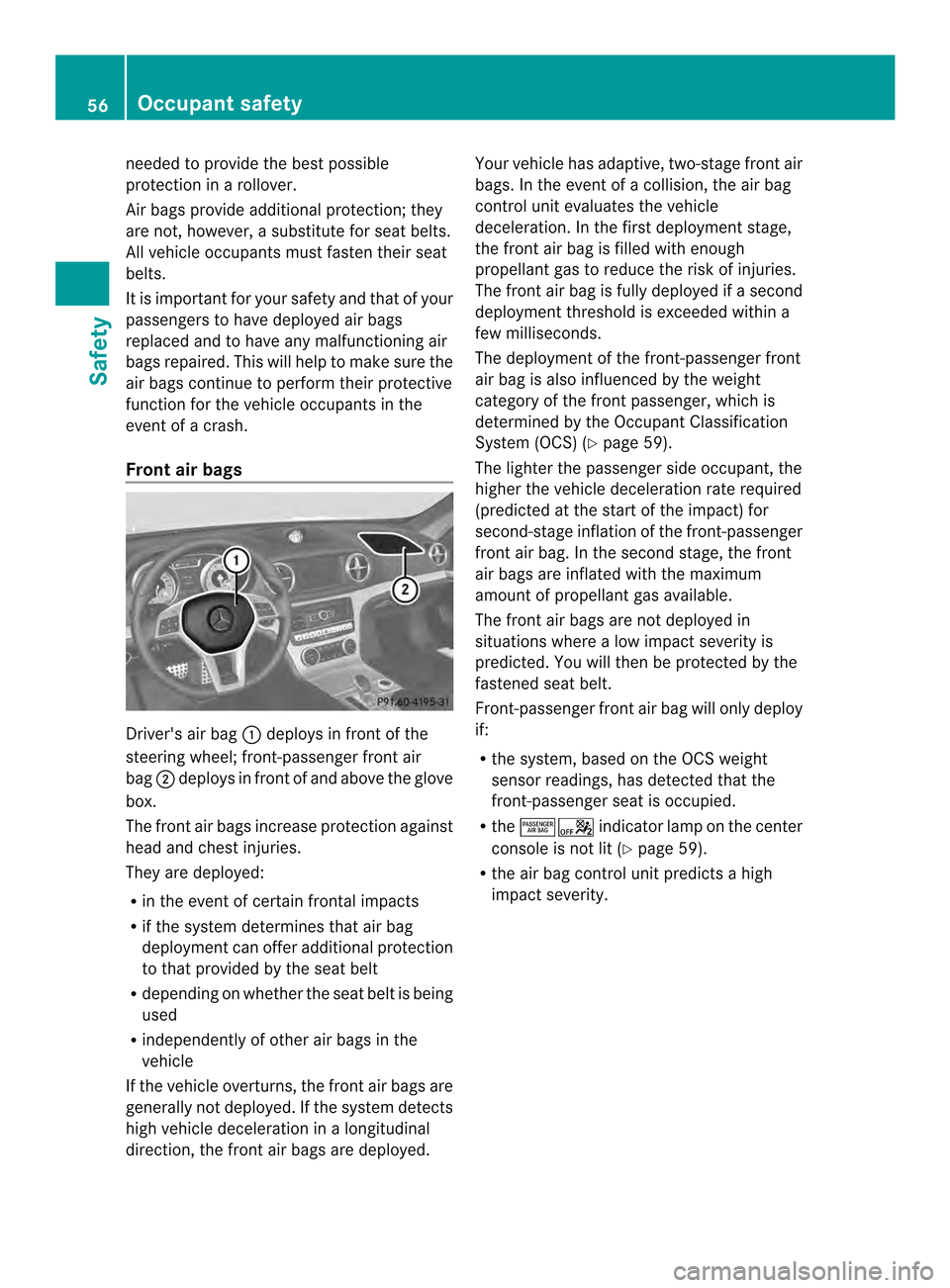
needed to provide the best possible
protection in a rollover.
Air bags provide additional protection; they
are not, however, a substitute for sea
tbelts.
All vehicle occupants must fasten their seat
belts.
It is important for your safety and that of your
passengers to have deployed air bags
replaced and to have any malfunctioning air
bags repaired. This will help to make sure the
air bags continue to perform their protective
function for the vehicle occupants in the
event of a crash.
Front air bags Driver's air bag
0002deploys in front of the
steering wheel; front-passenger fron tair
bag 0003deploys in front of and above the glove
box.
The front air bags increase protection against
head and ches tinjuries.
They are deployed:
R in the event of certain frontal impacts
R if the system determines tha tair bag
deploymen tcan offer additional protection
to that provided by the seat belt
R depending on whether the seat belt is being
used
R independently of other air bags in the
vehicle
If the vehicle overturns, the fron tair bags are
generally not deployed. If the system detects
high vehicle deceleration in alongitudinal
direction, the front air bags are deployed. Your vehicle has adaptive, two-stage front air
bags. In the event of a collision, the air bag
control unit evaluates the vehicle
deceleration. In the first deployment stage,
the front air bag is filled with enough
propellant gas to reduce the risk of injuries.
The front air bag is fully deployed if a second
deployment threshold is exceeded within a
few milliseconds.
The deployment of the front-passenger front
air bag is also influenced by the weight
category of the front passenger, which is
determined by the Occupant Classification
System (OCS) (Y page 59).
The lighter the passenger side occupant, the
higher the vehicle deceleration rate required
(predicted at the start of the impact) for
second-stage inflation of the front-passenger
front air bag. In the second stage, the front
air bags are inflated with the maximum
amount of propellant gas available.
The front air bags are not deployed in
situations where a low impact severity is
predicted. You will then be protected by the
fastened seat belt.
Front-passenger front air bag will only deploy
if:
R the system, based on the OCS weight
sensor readings, has detected that the
front-passenger seat is occupied.
R the 00040006 indicator lamp on the center
console is not lit (Y page 59).
R the air bag control unit predicts a high
impact severity. 56
Occupant safetySafety
Page 59 of 590
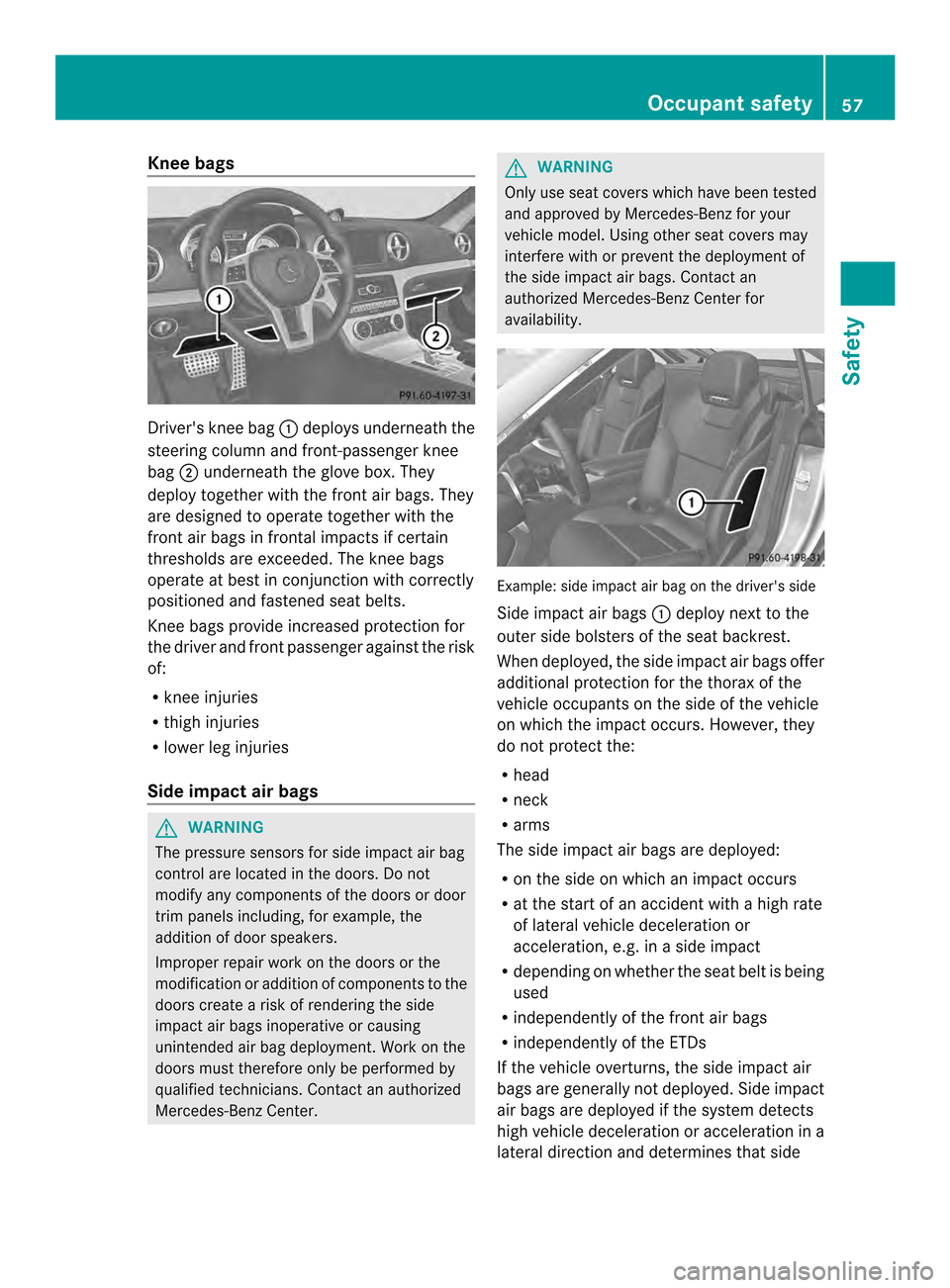
Knee bags
Driver's knee bag
0002deploys underneath the
steering column and front-passenger knee
bag 0003underneath the glove box .They
deploy together with the front air bags. They
are designed to operate together with the
front air bags in frontal impacts if certain
thresholds are exceeded. The knee bags
operate at best in conjunction with correctly
positioned and fastened seat belts.
Knee bags provide increased protection for
the driver and front passenger against the risk
of:
R knee injuries
R thigh injuries
R lower leg injuries
Side impact air bags G
WARNING
The pressure sensors for side impact air bag
control are located in the doors. Do not
modify any components of the doors or door
trim panels including, for example, the
addition of door speakers.
Improper repair work on the doors or the
modification or addition of components to the
doors create a risk of rendering the side
impact air bags inoperative or causing
unintended air bag deployment. Work on the
doors must therefore only be performed by
qualified technicians. Contact an authorized
Mercedes-Benz Center. G
WARNING
Only use seat covers which have been tested
and approved by Mercedes-Ben zfor your
vehicle model. Using other seat covers may
interfere with or prevent the deployment of
the side impact air bags. Contact an
authorized Mercedes-Benz Center for
availability. Example: side impact air bag on the driver's side
Side impact air bags
0002deploy next to the
outer side bolsters of the seat backrest.
When deployed, the side impact air bags offer
additional protection for the thorax of the
vehicle occupants on the side of the vehicle
on which the impact occurs. However, they
do not protect the:
R head
R neck
R arms
The side impact air bags are deployed:
R on the side on which an impact occurs
R at the start of an accident with a high rate
of lateral vehicle deceleration or
acceleration, e.g. in aside impact
R depending on whether the seat belt is being
used
R independently of the front air bags
R independently of the ETDs
If the vehicle overturns, the side impac tair
bags are generally not deployed. Side impact
air bags are deployed if the system detects
high vehicle deceleration or acceleration in a
lateral direction and determines that side Occupant safety
57Safety Z
Page 61 of 590
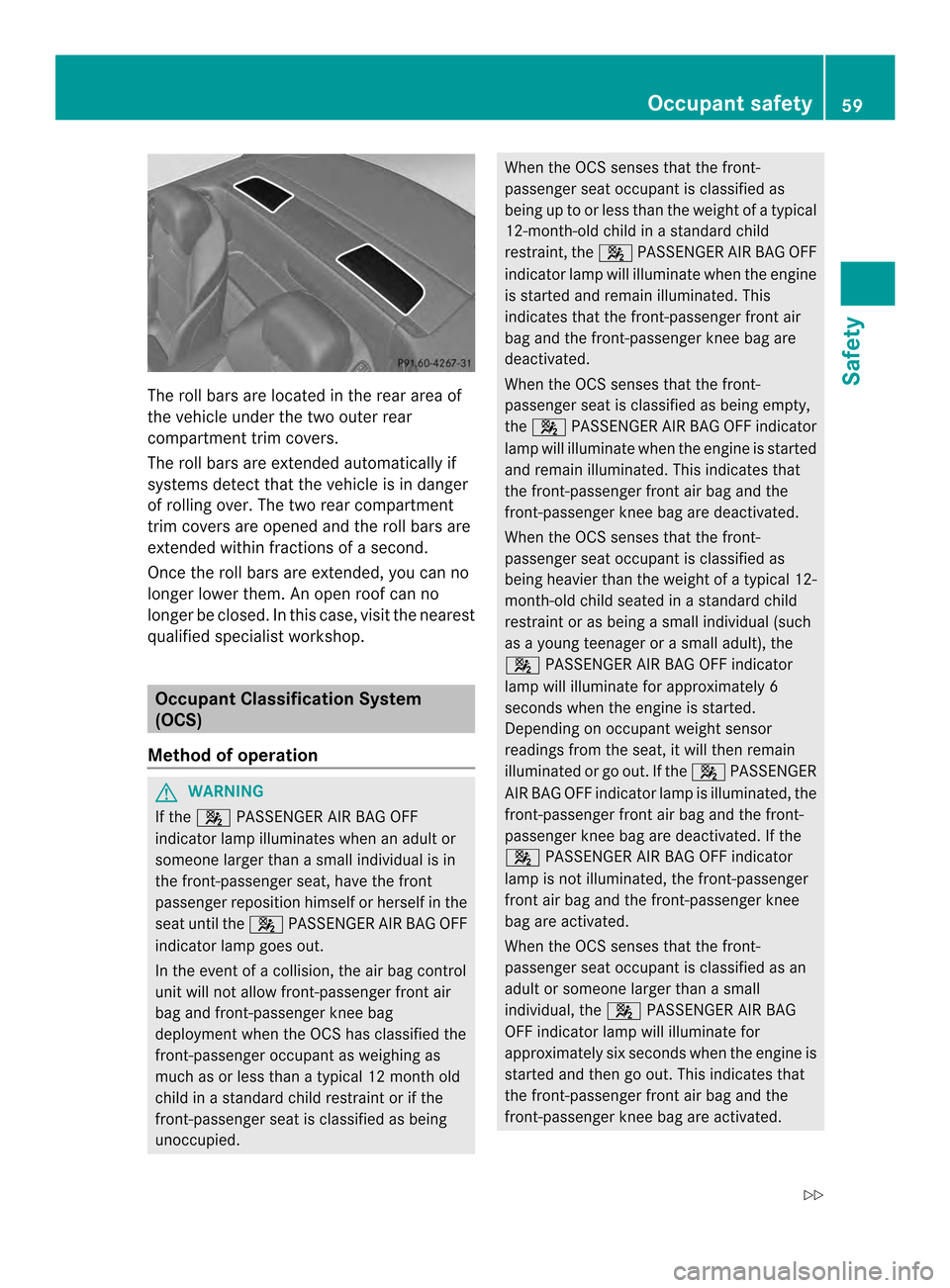
The roll bars are located in the rear area of
the vehicle under the two outer rear
compartment trim covers.
The roll bars are extended automatically if
systems detect that the vehicle is in danger
of rolling over. The two rear compartment
trim covers are opened and the roll bars are
extended within fractions of a second.
Once the roll bars are extended, you can no
longer lower them. An open roof can no
longer be closed. In this case, visit the nearest
qualified specialist workshop. Occupant Classification System
(OCS)
Method of operation G
WARNING
If the 0016 PASSENGER AIR BAG OFF
indicator lamp illuminates when an adult or
someone larger than a small individual is in
the front-passenger seat, have the front
passenger reposition himself or herself in the
seat until the 0016PASSENGER AIR BAG OFF
indicator lamp goes out.
In the event of a collision, the air bag control
unit will not allow front-passenger fronta ir
bag and front-passenge rknee bag
deployment when the OC Shas classified the
front-passenger occupant as weighing as
much as or less than a typical 12 month old
child in a standard child restraint or if the
front-passenger seat is classified as being
unoccupied. When the OCS senses that the front-
passenger seat occupant is classified as
being up to or less than the weigh
tofatypical
12-month-old child in a standard child
restraint, the 0016PASSENGER AIR BAG OFF
indicator lamp will illuminate when the engine
is started and remai nilluminated. This
indicates that the front-passenger front air
bag and the front-passenge rknee bag are
deactivated.
When the OCS senses that the front-
passenger sea tis classified as being empty,
the 0016 PASSENGER AIR BAG OFF indicator
lamp will illuminate when the engine is started
and remain illuminated. This indicates that
the front-passenger front air bag and the
front-passenger knee bag are deactivated.
When the OCS senses that the front-
passenger seat occupant is classified as
being heavier than the weight of a typical 12-
month-old child seated in astandard child
restraint or as being a small individual (such
as a young teenager or asmall adult), the
0016 PASSENGER AIR BAG OFF indicator
lamp will illuminate for approximately 6
seconds when the engine is started.
Depending on occupant weight sensor
readings from the seat, it will then remain
illuminated or go out. If the 0016PASSENGER
AIR BAG OFF indicator lamp is illuminated, the
front-passenger front air bag and the front-
passenger knee bag are deactivated. If the
0016 PASSENGER AIR BAG OFF indicator
lamp is not illuminated, the front-passenger
front air bag and the front-passenger knee
bag are activated.
When the OCS senses that the front-
passenger seat occupant is classified as an
adult or someone larger than a small
individual, the 0016PASSENGER AIR BAG
OFF indicator lamp will illuminate for
approximately six seconds when the engine is
started and then go out. This indicates that
the front-passenger front air bag and the
front-passenger knee bag are activated. Occupant safety
59Safety
Z
Page 63 of 590
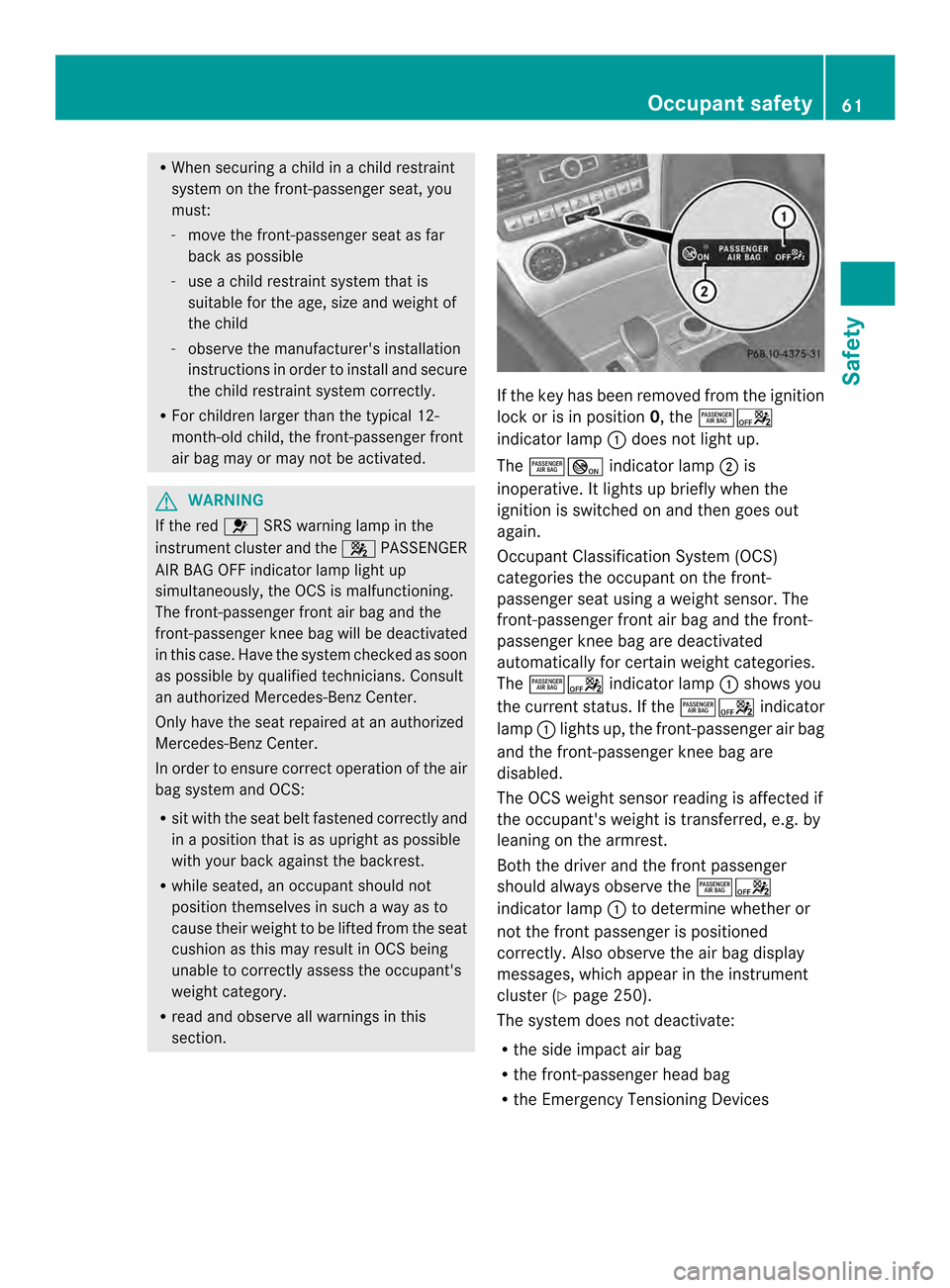
R
When securing a child in achild restraint
system on the front-passenger seat, you
must:
- move the front-passenger seat as far
back as possible
- use a child restraint system that is
suitable for the age, size and weight of
the child
- observe the manufacturer's installation
instructions in order to install and secure
the child restraint system correctly.
R For children larger than the typical 12-
month-old child, the front-passenger front
air bag may or may not be activated. G
WARNING
If the red 001BSRS warning lamp in the
instrument cluster and the 0016PASSENGER
AIR BAG OFF indicator lamp light up
simultaneously, the OCS is malfunctioning.
The front-passenger front air bag and the
front-passenger knee bag will be deactivated
in this case. Have the system checked as soon
as possible by qualified technicians. Consult
an authorized Mercedes-Ben zCenter.
Only have the seat repaired at an authorized
Mercedes-Benz Center.
In order to ensure correct operation of the air
bag system and OCS:
R sit with the seat belt fastened correctly and
in a position that is as upright as possible
with your back against the backrest.
R while seated, an occupant should not
position themselves in such away as to
cause their weigh tto be lifted from the seat
cushion as this may result in OCS being
unable to correctly assess the occupant's
weight category.
R read and observe all warnings in this
section. If the key has been removed from the ignition
lock or is in position
0, the00040006
indicator lamp 0002does not light up.
The 00040005 indicator lamp 0003is
inoperative. It lights up briefly when the
ignition is switched on and then goes out
again.
Occupant Classification System (OCS)
categories the occupant on the front-
passenger seat using a weight sensor. The
front-passenger front air bag and the front-
passenger knee bag are deactivated
automatically for certain weight categories.
The 00040006 indicator lamp 0002shows you
the current status. If the 00040006indicator
lamp 0002lights up, the front-passenger air bag
and the front-passenger knee bag are
disabled.
The OCS weight sensor reading is affected if
the occupant's weight is transferred, e.g. by
leaning on the armrest.
Both the driver and the front passenger
should always observe the 00040006
indicator lamp 0002to determine whether or
not the front passenger is positioned
correctly. Also observe the air bag display
messages, which appear in the instrument
cluster (Y page 250).
The system does not deactivate:
R the side impact air bag
R the front-passenger head bag
R the Emergency Tensioning Devices Occupant safety
61Safety Z
Page 66 of 590
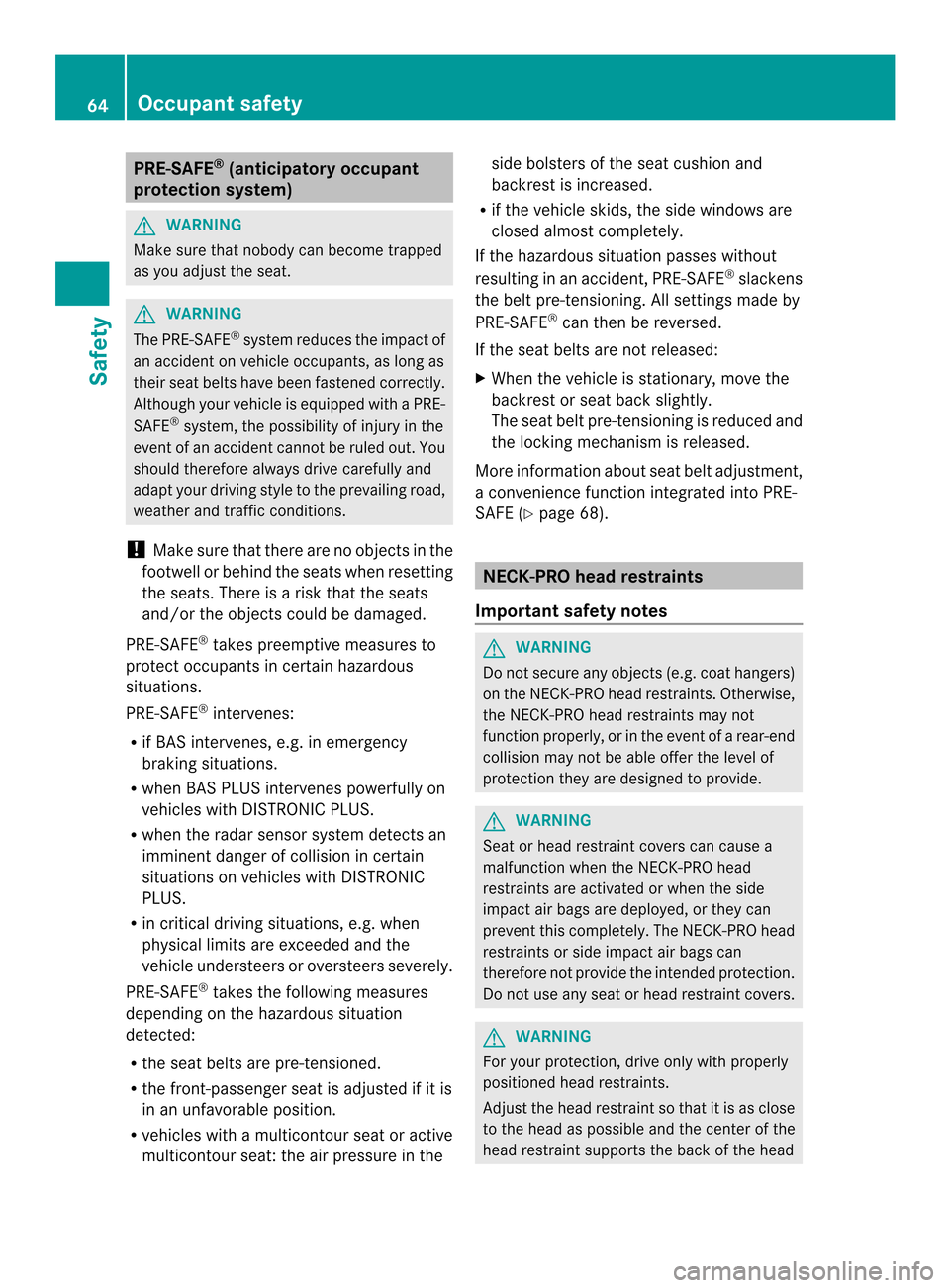
PRE-SAFE
®
(anticipatory occupant
protection system) G
WARNING
Make sure that nobody can become trapped
as you adjust the seat. G
WARNING
The PRE-SAFE ®
system reduces the impact of
an accident on vehicle occupants, as long as
their seat belts have been fastened correctly.
Although your vehicle is equipped with a PRE-
SAFE ®
system, the possibility of injury in the
event of an accident cannot be ruled out. You
should therefore always drive carefully and
adapt your driving style to the prevailing road,
weather and traffic conditions.
! Make sure that there are no objects in the
footwell or behind the seats when resetting
the seats. There is a risk that the seats
and/or the objects could be damaged.
PRE-SAFE ®
takes preemptive measures to
protect occupants in certain hazardous
situations.
PRE-SAFE ®
intervenes:
R if BAS intervenes, e.g. in emergency
braking situations.
R when BAS PLUS intervenes powerfully on
vehicles with DISTRONIC PLUS.
R when the radar sensor system detects an
imminent danger of collision in certain
situations on vehicles with DISTRONIC
PLUS.
R in critical driving situations, e.g. when
physical limits are exceeded and the
vehicle understeers or oversteers severely.
PRE-SAFE ®
takes the following measures
depending on the hazardous situation
detected:
R the seat belts are pre-tensioned.
R the front-passenger seat is adjusted if it is
in an unfavorable position.
R vehicles with a multicontour seat or active
multicontour seat: the air pressure in the side bolsters of the seat cushion and
backrest is increased.
R if the vehicle skids, the side windows are
closed almost completely.
If the hazardous situation passes without
resulting in an accident, PRE-SAFE ®
slackens
the belt pre-tensioning. All settings made by
PRE-SAFE ®
can then be reversed.
If the seat belts are not released:
X When the vehicle is stationary, move the
backrest or seat back slightly.
The seat belt pre-tensioning is reduced and
the locking mechanism is released.
More information about seat belt adjustment,
a convenience function integrated into PRE-
SAFE (Y page 68). NECK-PRO head restraints
Important safety notes G
WARNING
Do not secure any objects (e.g. coat hangers)
on the NECK-PRO head restraints. Otherwise,
the NECK-PRO head restraints may not
function properly, or in the event of a rear-end
collision may not be able offer the level of
protection they are designed to provide. G
WARNING
Seat or head restraint covers can cause a
malfunction when the NECK-PRO head
restraints are activated or when the side
impact air bags are deployed, or they can
prevent this completely. The NECK-PRO head
restraints or side impact air bags can
therefore not provide the intended protection.
Do not use any seat or head restraint covers. G
WARNING
For your protection, drive only with properly
positioned head restraints.
Adjust the head restraint so that it is as close
to the head as possible and the center of the
head restraint supports the back of the head 64
Occupant safetySafety